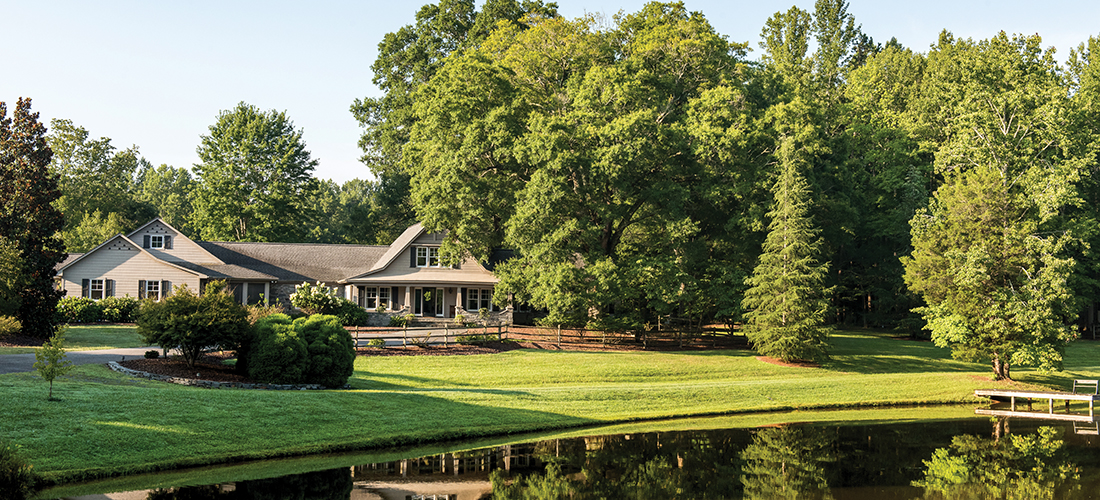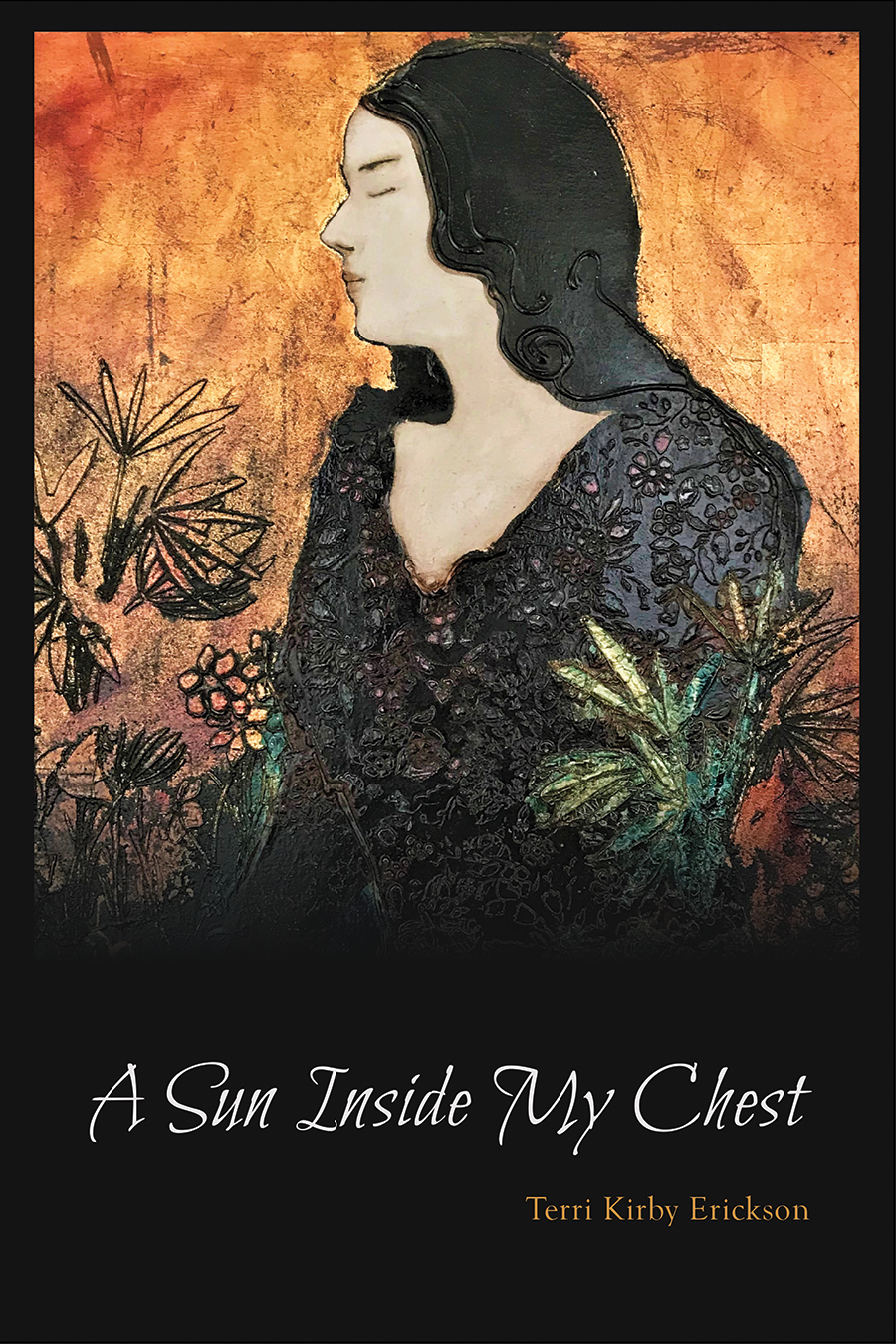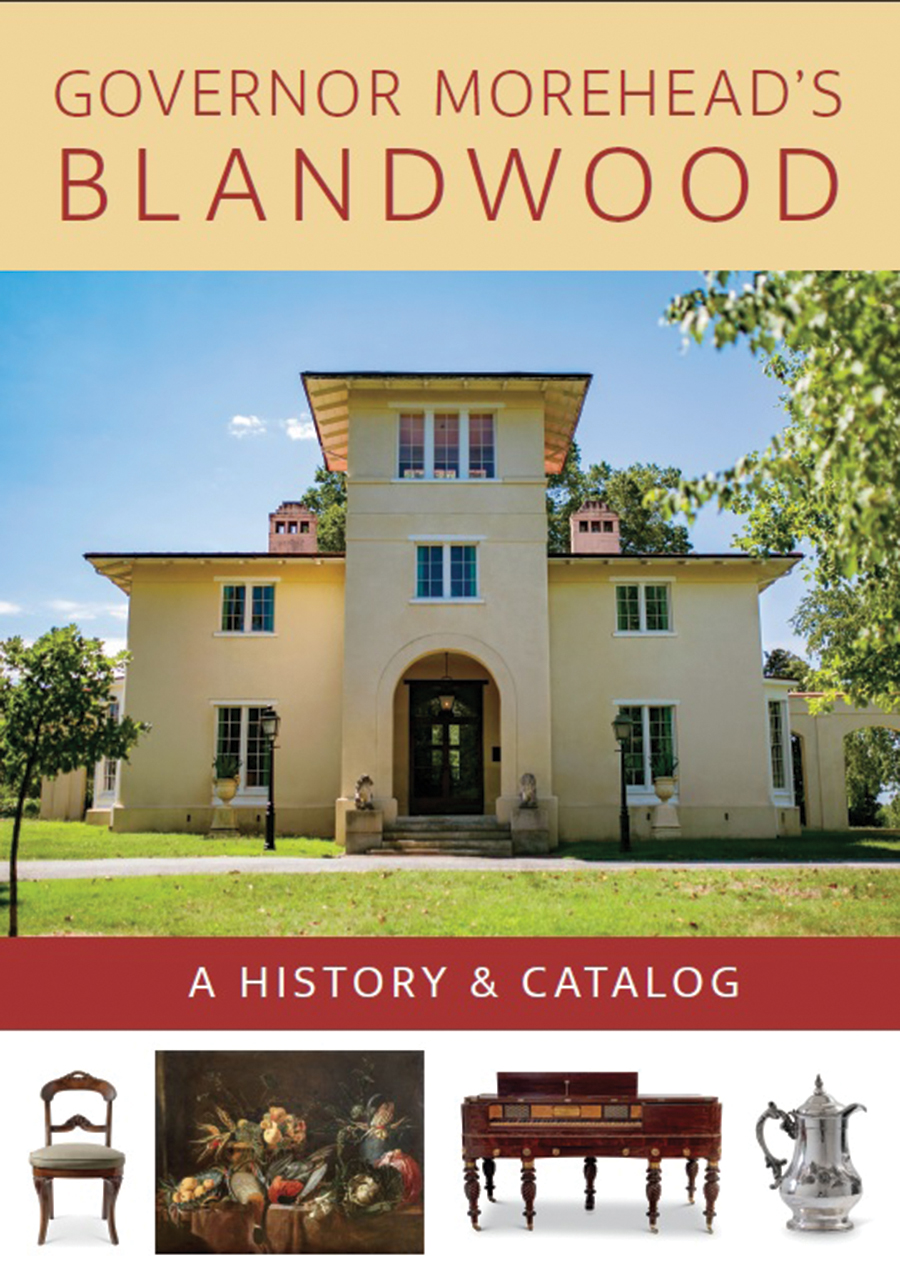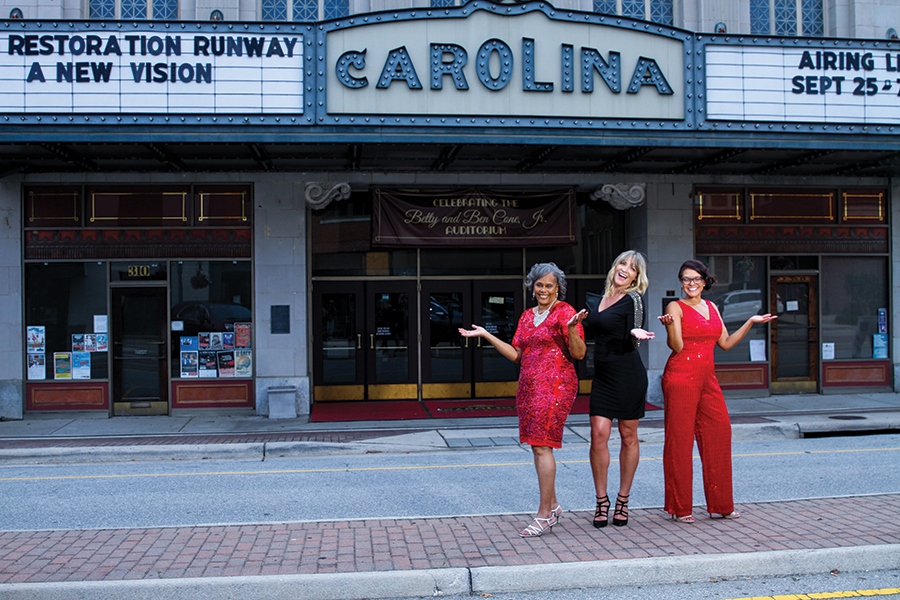Flagstone Farm fuses past and present
By Cynthia Adams • Photographs by Amy Freeman
For years, Missy Rankin worked in commercial and residential design at an Asheboro firm with partner Dede Reese. But her opus is Flagstone Farm, where she used those skills in service to a larger purpose.
“Ultimately function and form come together” is Rankin’s design philosophy. Over time, a legacy property and family heirlooms found new life.
Missy and her husband, Sam, thoughtfully improved a 40-acre property they acquired from a family friend in 1993. They made refinements with close attention to the farm’s rustic beauty. The name itself is a nod to a significant feature on the property: the stone itself.
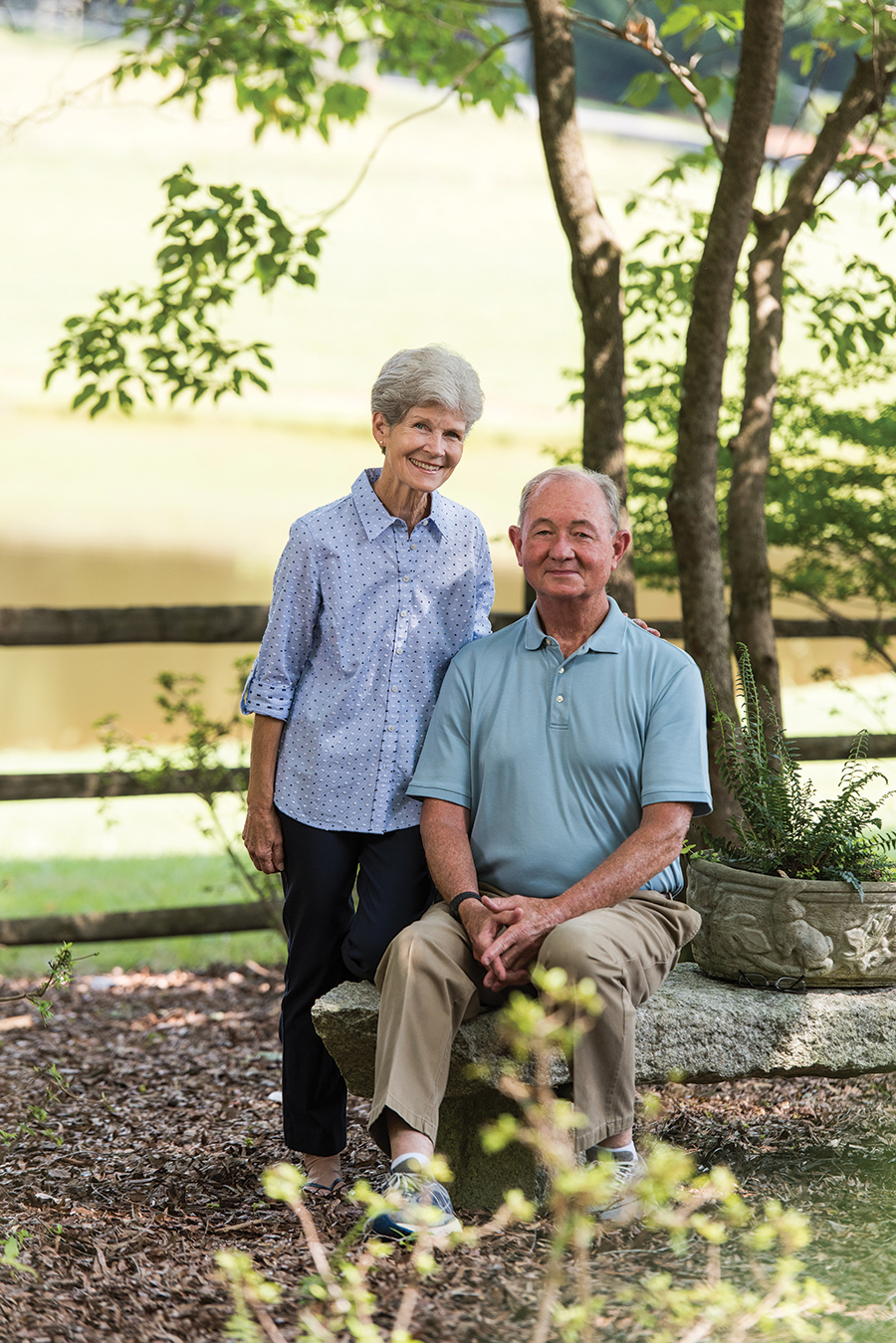
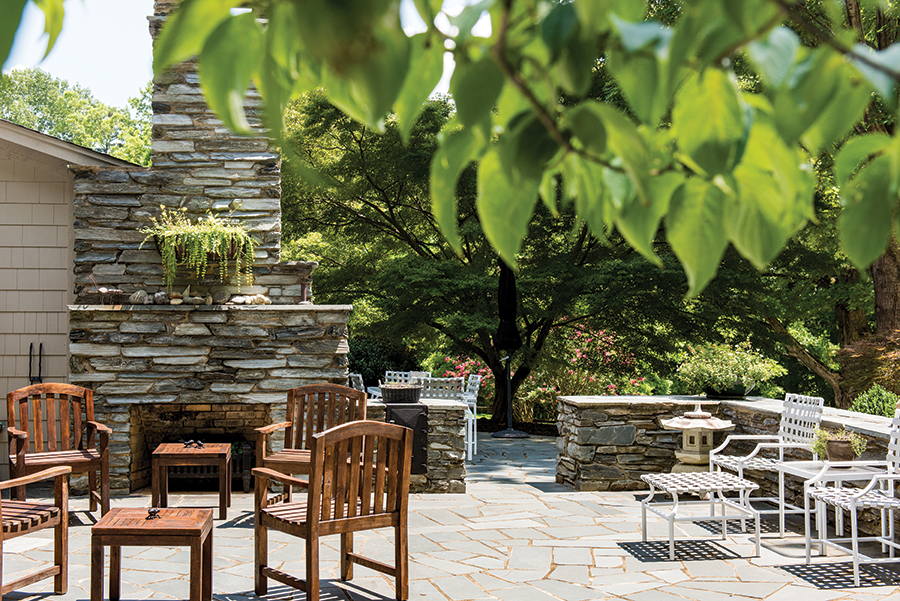
“Sam and I named our house ‘Flagstone Farm’ [because of the quarry and the use of that stone in the 1948 house construction] when we bought it from Charles McCrary’s family,” says Rankin.
The quarry was the source of the home’s original blue-slate exterior fireplace chimneys and terraces.
“We’re sitting on the northernmost vein of Carolina blue stone of the Uwharrie Mountains,” Rankin continues. “The original family dug a quarry and excavated the stone for the house and then offered the quarry to people building homes.”
Evidence of this generosity is easily visible along Asheboro’s city streets. “Several homes in town and a church, are built of slate,” she adds.
“The patio and its walls, walkways and fireplace are built from stone from the quarry, as is the one fireplace in the house. The garden pathway is constructed of old brick and bluestone we found on the property. Sam and I built that walkway before planting the garden,” says Rankin.
Brothers Charles and Frank McCrary, sons of Asheboro industrialist D. B. McCrary, built a pair of summer residences at Flagstone Farm.
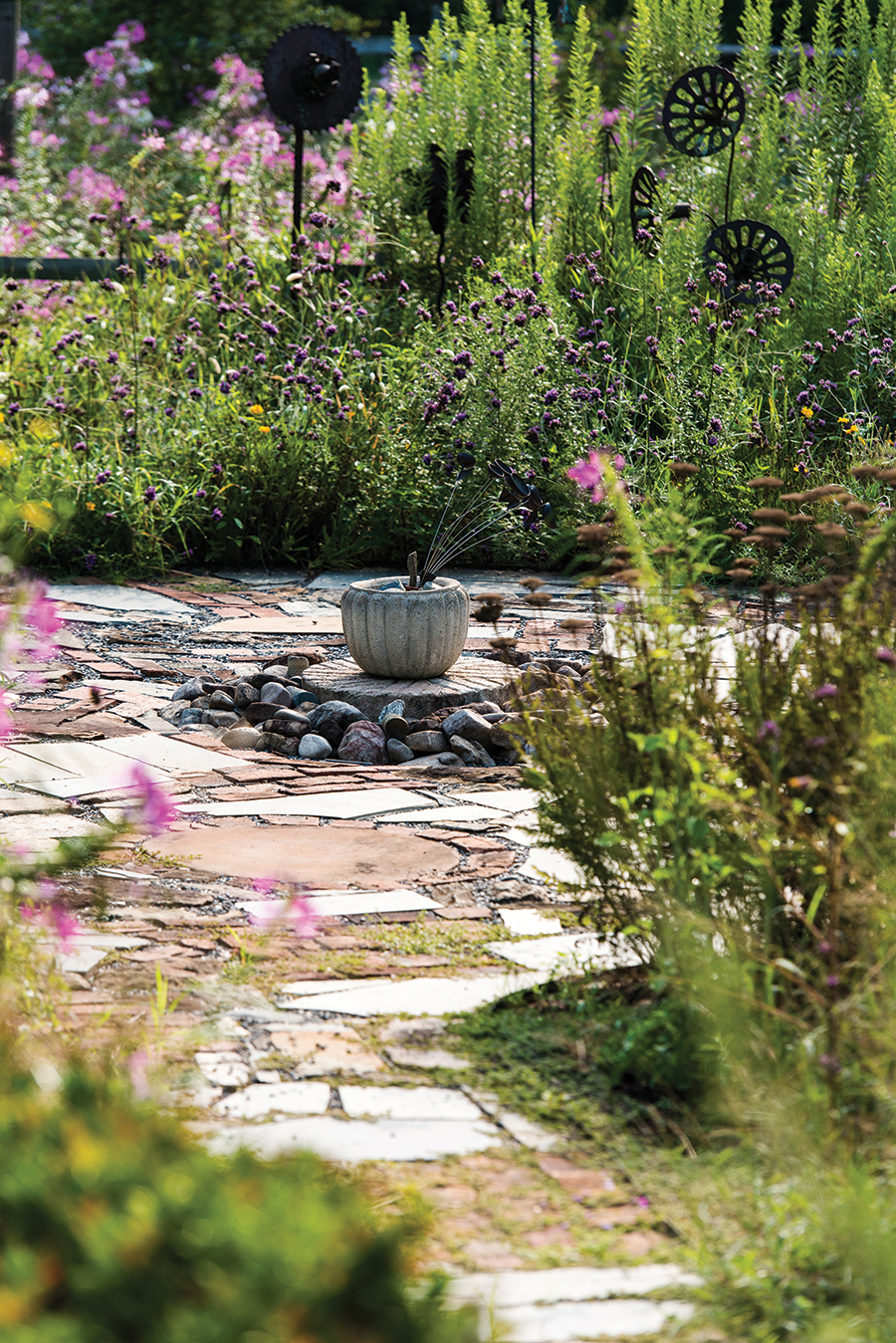
“In 1947–48 Charles and Frank built the two ‘country’ houses (where we now live) on the west side of town. That land had been in the McCrary family for years as farmland,” Rankin explains.
It was mere miles from the McCrary’s stately homes in downtown Asheboro near the Acme-McCrary Hosiery Mill complex of buildings (now listed on the National Register of Historic Places.) The McCrary and Moser families were old friends. Rankin’s father, attorney Wescott Moser, “was devoted to his hometown, contributing to the community with his time and energy his entire life,” says Rankin.
Moser served on the City Council and as Mayor pro tem. But his most remembered work was co-chairing the Randolph County Zoological Committee with David Stedman in the 1970s. (In early developmental stages, there were various groups established to “garner public support for the zoo and to raise funds” according to press reports.)
“This committee’s efforts established the Zoo firmly in Asheboro,” says Rankin. “He was a member of the NC Zoological Authority and remained active in the NC Zoological Society until his death.”
Manufacturing was interwoven with her husband, Sam’s family. His father, Sam Rankin Sr., founded Ramseur Interlock Knitting Co. in the mid-1940s.
Missy and Sam met when she was in high school. Sam was graduating from college and going abroad for textile studies. They married after her second year at UNCG; she completed her interior design degree.
After acquiring the farm, they decamped from town whenever possible with their growing family of three children. The fenced pastures enabled the couple to keep horses. “We were ready to bring them out of boarding.”
For over a decade, the Rankins left the original home unaltered, occasionally renting it short-term during the furniture market or when families were building a home. “It was long, basically an early ranch, even though designed by an architect in Asheboro and built in 1948,” she adds.

“It looked like a long, gray house.” Judging by vintage photos of the deft remaking, the now handsome country home on rolling farmlands responded to the couple’s bucolic improvements. A split-rail fence and a new pond were redolent of the Uwharrie Mountains.
In 2004, the couple decided to make the retreat a permanent home, beginning renovations and constructing a cottage, which they completed in March of 2005.
They wished to preserve a sense of place, yet add functionality.
“Sam and I are project-oriented; I create, and he engineers,” says Rankin.
His hobbies grew to include woodworking, metal sculpting, even intricate needlepoint projects, detailed and often historic in nature. (“He watched my mother do it and was fascinated,” she explains.) His original works are featured throughout the property: as sculptures, custom gates and wood furniture made from felled walnut trees.
The family occupied a new cottage on the property while completing the renovation of the primary house. Rankin, who is not a fan of disposable design, thought long about how she would approach the renovations. Things that could be recycled and reused, like the old kitchen’s hardwood countertops, were cut down and used in the cottage’s kitchen. “Reduce, reuse, recycle,” noted Rankin in her design notebook. She sits on a screened porch they added, now furnished with the McCrary’s rattan front porch furniture. The front porch was integrated into the main living areas and a more expansive porch configured.
The original house in “before” photos is a departure from the beauty of the present. With a generous front porch, gray-painted exterior-shingle siding plus stacked stone features, the “after” evokes the architectural style of Blowing Rock, where the Rankins have a vacation home.

Inside, the kitchen was moved, bedrooms were reoriented, and practical needs were addressed to accommodate a family of five. (It lacked even a laundry room.) But the footprint of the house was gently, sympathetically, altered and enlarged.
An example is the foyer, expanded in the remodel, which features ash flooring. Rankin herself carefully distressed it, marrying the wormy chestnut (and now priceless) flooring material that is preserved throughout the house. The foyer’s new ash flooring abuts the original chestnut flooring in a perfect, imperceptible, match.
With a vaulted ceiling complete with beams in the main room there was much to like about the original house, she says. But it was dark, with unpainted wood on walls, ceilings and floors that were then in vogue.
By painting the wood paneling and ceilings Rankin dramatically lightened the largest and most dramatic room.
The house is a display of her designer strengths and restraint. The old and new merged into an improved entity.
It is a marriage of repurposed, or recycled, materials and something even more important. Much like a magician’s sleight of hand, Rankin seems capable of disappearing into her work.
The understated interiors allow prized heirlooms and art to take center stage. Many of the furnishings are ancestral.
“Sug’s chairs,” she indicates, pointing to a pair of wing chairs. “Sug” Moser, her paternal grandmother, lived with the family until Rankin was 15.

Handsome keepsakes populate the rooms: a hunt board, corner cupboard and sideboard. Family portraits are on view, as well as the work of artist David L. Bass. Sam’s prize-winning needlepoint rug hangs prominently in the living room.
The front study is painted mossy green, a departure from the rest of the house where walls, trim and ceilings are painted Sherwin-Williams’ Muslin to unify the space.
The neutrality and quietness of the architecture is a canvas, showcasing a dramatic collection of Chinoiseries, art, and artifacts.
Lelia Judson Tuttle, Rankin’s great-great aunt, amassed a collection that figures prominently into the home.
Tuttle graduated from the State Normal and Industrial College (now UNCG) in 1900. She earned a graduate degree at Columbia University in New York then taught at Davenport College in Lenoir before undertaking religious studies to become a Methodist missionary.
In 1910, Tuttle embarked alone to China, accepting a position as chair of English literature at the McTyeire School for Girls in Shanghai. She worked there until 1926, when she transferred to Soochow University and became Dean of Women and professor of English and history.


“Her portrait still hangs on a wall there,” says Rankin.
She forged powerful connections to China’s leading political lights, having taught the children of Charlie Soong, a wealthy man who returned to China after being educated at Duke, thanks to his benefactor James B. Duke.
Soong’s children went on to become powerful figures. “One married Sun Yat-sen, and another married Chiang Kai-shek,” says Rankin.
“Madame Chaing became very well-known for her own personal strengths alongside her very powerful husband,” she adds. “Lelia attended their wedding. The sisters stayed in touch with Lelia as they aged, sending her lovely gifts of Chinese handwork for many years. These gifts form the basis of a huge collection that Lelia amassed and later distributed much of to her nieces and nephews.”
Tuttle dedicated most of her income to purchasing Chinese objets d’art. She sent home elaborate letters written on scrolls of handmade paper, now housed in the Special Collection at UNCG’s Jackson Library, along with other artifacts.
In 1942, the invasion of Shanghai and Japanese occupation necessitated her departure. When Tuttle returned to Caldwell County that year, she purchased a home near her family’s home place, later donating inherited lands to create the Tuttle Forest Foundation. The Tuttle Educational State Forest is managed by the N.C. Forest Service.
Tuttle’s kinship with the Chinese people and culture was profound.
The precious items eventually entrusted to Rankin include porcelains, artwork, paintings and textiles, and a Scholar’s Robe that predates the collapse of the Qing Dynasty.
Over time, however, even the new cottage at Flagstone Farm claimed its own identity. It became a part of the tight-knit, Asheboro community.

“The cottage became a guest house,” Rankin explains. And it was also a pastoral meeting place for volunteer interests like the Friends of the Library.
Rankin, a voracious reader, invited one notable writer friend to stay there on more than one occasion. “Wiley Cash stayed here and wrote,” she adds. He won the O. Henry Award for his writing — possibly for what he wrote while there.
It seems that the Rankins also shared in a sense of conservatorship.
Flagstone Farm has become a nature preserve; deer wander through on their daily circuit. “I cannot begin to tell you how many deer are here,” Rankin smiles. If they munch the plants, she doesn’t even mind or shoo them away.
“Fish in the pond, wild turkey — and we once had sheep and donkey.”
The sheep and donkey were rehomed by the zoo where Rankin has long volunteered. The family took them in with glee.
She notes, happily, “nature shows up all the time, including migrating geese.” With the same admiration Rankin expressed in showing off her aunt’s precious artifacts, her face lights up observing a configuration of clouds.
The clouds, multicolored marshmallows, bobble across the sky beyond the pond. It adds to the farm’s abundant wildlife, enriching the nature show that Rankin “could watch from the screen porch all morning long.”
There is no spring feeding the pond, Rankin explains. They created it from an open pasture, stocked it with fish, and added a simple pier. She likes to paddle out onto the pond in an old Girl Scout’s canoe, she muses. The grandchildren like swimming there.
The pond, a languid part of the foreground, now reflects a moody sky.
A storm is gathering and the clouds dimple with intensifying color.
Rankin points a finger upward. “Just look at that!”
She grows quite still, simply observing. Nothing, not even beloved heirlooms, can top pleasure taken from the natural world. OH
Lelia Tuttle’s collection of Chinese artifacts includes letters, records and memorabilia. Missy Rankin (class of ’76) and family arranged for the donation to the UNCG University Archives in July 2004.




